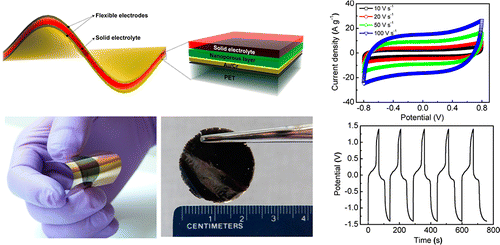Energy device for flexible electronics packs a lot of power

While flexible gadgets such as "electronic skin" and roll-up touch screens are moving ever closer to reality, their would-be power sources are either too wimpy or too stiff. But that's changing fast. Scientists have developed a new device that's far thinner than paper, can flex and bend, and store enough energy to provide critical back-up power for portable electronics.
Their report appears in the Journal of the American Chemical Society.
In their paper, James Tour and colleagues point out that many materials that have been investigated for energy storage potential are pliant but don't pack much power, or they can load up on energy but are rigid. These include polymers and carbon-based materials such as carbon nanotubes, which have been all the rage for certain applications. But these materials fall short as reliable supercapacitors, which are batteries' lesser-known cousins that step in when the main energy source peters out. Seeking a better solution to this energy hurdle, Tour's team took a different approach.
They figured out a way to make a flexible thin film out of nickel and fluoride that is full of tiny holes, or nanopores. These pores throughout the material allow ions to flow easily, a critical feature for an energy device. The resulting structure can pack in far more power for its size.
The researchers show that they can bend and fold the thin film and recharge it thousands of times with little loss in performance. They also say that manufacturers could easily scale up the process for mass production.
More information: "Flexible Three-Dimensional Nanoporous Metal-Based Energy Devices" J. Am. Chem. Soc., 2014, 136 (17), pp 6187–6190. DOI: 10.1021/ja501247f
Abstract
A flexible three-dimensional (3-D) nanoporous NiF2-dominant layer on poly(ethylene terephthalate) has been developed. The nanoporous layer itself can be freestanding without adding any supporting carbon materials or conducting polymers. By assembling the nanoporous layer into two-electrode symmetric devices, the inorganic material delivers battery-like thin-film supercapacitive performance with a maximum capacitance of 66 mF cm–2 (733 F cm–3 or 358 F g–1), energy density of 384 Wh kg–1, and power density of 112 kW kg–1. Flexibility and cyclability tests show that the nanoporous layer maintains its high performance under long-term cycling and different bending conditions. The fabrication of the 3-D nanoporous NiF2 flexible electrode could be easily scaled.
Journal information: Journal of the American Chemical Society
Provided by American Chemical Society


















